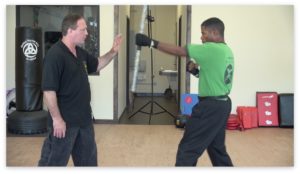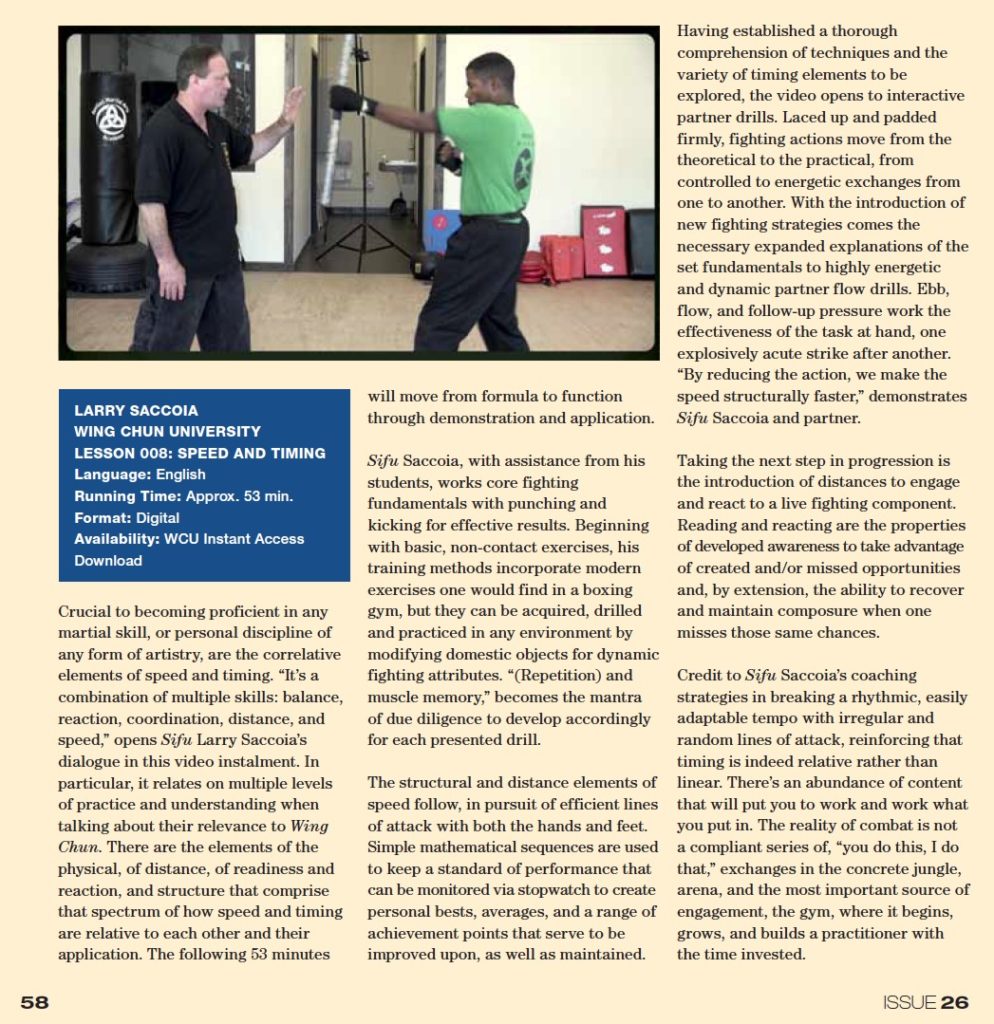Crucial to becoming proficient in any martial skill, or personal discipline of any form of artistry, are the correlative elements of speed and timing. “It’s a combination of multiple skills: balance, reaction, coordination, distance, and speed,” opens Sifu Larry Saccoia’s dialogue in this video installment. In particular, it relates on multiple levels of practice and understanding when talking about their relevance to Wing Chun. There are the elements of the physical, of distance, of readiness and reaction, and structure that comprise that spectrum of how speed and timing are relative to each other and their application. The following 53 minutes will move from formula to function through demonstration and application.
Sifu Saccoia, with assistance from his students, works core fighting fundamentals with punching and kicking for effective results. Beginning with basic, non-contact exercises, his training methods incorporate modern exercises one would find in a boxing gym, but they can be acquired, drilled and practiced in any environment by modifying domestic objects for dynamic fighting attributes. “(Repetition) and muscle memory,” becomes the mantra of due diligence to develop accordingly for each presented drill.
 The structural and distance elements of speed follow, in pursuit of efficient lines of attack with both the hands and feet. Simple mathematical sequences are used to keep a standard of performance that can be monitored via stopwatch to create personal bests, averages, and a range of achievement points that serve to be improved upon, as well as maintained. Having established a thorough comprehension of techniques and the variety of timing elements to be explored, the video opens to interactive partner drills. Laced up and padded firmly, fighting actions move from the theoretical to the practical, from controlled to energetic exchanges from one to another. With he introduction of new fighting strategies comes the necessary expanded explanations of the set fundamentals to highly energetic and dynamic partner flow drills. Ebb, flow, and follow-up pressure work the effectiveness of the task at hand, one explosively acute strike after another. “By reducing the action, we make the speed structurally faster,” demonstrates Sifu Saccoia and partner.
The structural and distance elements of speed follow, in pursuit of efficient lines of attack with both the hands and feet. Simple mathematical sequences are used to keep a standard of performance that can be monitored via stopwatch to create personal bests, averages, and a range of achievement points that serve to be improved upon, as well as maintained. Having established a thorough comprehension of techniques and the variety of timing elements to be explored, the video opens to interactive partner drills. Laced up and padded firmly, fighting actions move from the theoretical to the practical, from controlled to energetic exchanges from one to another. With he introduction of new fighting strategies comes the necessary expanded explanations of the set fundamentals to highly energetic and dynamic partner flow drills. Ebb, flow, and follow-up pressure work the effectiveness of the task at hand, one explosively acute strike after another. “By reducing the action, we make the speed structurally faster,” demonstrates Sifu Saccoia and partner.
Taking the next step in progression is the introduction of distances to engage and react to a live fighting component. Reading and reacting are the properties of developed awareness to take advantage of created and/or missed opportunities and, by extension, the ability to recover and maintain composure when one misses those same chances.
Credit to Sifu Saccoia’s coaching strategies in breaking a rhythmic, easily adaptable tempo with irregular and random lines of attack, reinforcing that timing is indeed relative rather than linear. There’s an abundance of content that will put you to work and work what you put in. The reality of combat is not a compliant series of, “you do this, I do that,” exchanges in the concrete jungle, arena, and the most important source of engagement, the gym, where it begins, grows, and builds a practitioner with the time invested.
LARRY SACCOIA WING CHUN UNIVERSITY LESSON 008: SPEED AND TIMING
Buy Now from the Wing Chun University
Language: English
Running Time: Approx. 53 min.
Format: Digital
Availability: WCU Instant Access Download

